The fan is not a complicated device. It consists of a motor, blades, various adjustment buttons and a stand-case. There are additional elements, such as backlighting, watches, but these are options that are not so important.
It is not necessary to buy a fan, because it will turn out to be done by yourself. Moreover, this does not require special skills of the master.
With the proper skill, a self-made model will turn out not to be a way to get rid of old things, but an opportunity to show imagination and, possibly, hidden talents. Some craftsmen quite simply get both functional and extremely attractive options. They harmoniously complement the interior and become the center of attention no worse than any art object.
How to make a fan out of a regular electric motor
Probably the easiest and fastest way to get a hand-assembled homemade fan is to find a regular motor, which is most often found in toys.
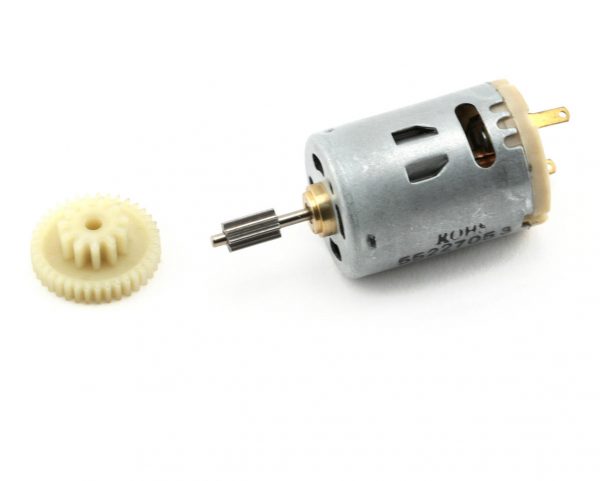
Standard electric motor from a toy
To order such a little thing is not difficult. Moreover, today, without stopping for a minute, caravans of various trinkets from the Middle Kingdom are cruising. And if not, then it’s enough to buy an inexpensive toy car and remove the motor from it.
But you should definitely not expect the impossible from such a device. Rather, it can only chase air slightly. But for a desktop model, it’ll work. He will be able to blow out the face of someone sitting at the computer.
For such a fan, you can use absolutely anything. The main parts will be:
- blades;
- motor;
- on / off button;
- stand;
- supply system.
Otherwise, the limit of the idea will lie only within the boundaries of fantasy.
After the motor is ready for use, it makes sense to take care of the power. It can be batteries, as in the toy for which the motor was intended. But, definitely, such energy will not last long. However, there is a plus - the device will retain its compactness and mobility.
The second option is mains power. But in this case you need not to overdo it. Direct connection via a plug is the right way for the motor to burn out. So do not experiment, trying to spin the engine to high revs. On toys, electric motors are usually designed for 3-4.5 Volts, and the desire to give more rotation due to powerful energy sources, firstly, quickly plant the source (if it is a battery), and secondly, seriously reduce the fan resource until it breaks down. The engine will start to heat up, brushes may melt.
But modern chargers convert voltage in the network, reducing it to the specified parameters. You can find a power supply, including for sale, which is ideal for the motor perfectly.
To create the blades, you can already take any material. The main thing is that it be light. Due to the weakness of the motor, the less the blades weigh, the faster the rotation, and, therefore, the efficiency of the work.
- The easiest option is to take a cork from a regular plastic bottle, which will serve as the fastening of the blades. Drill a hole in the bottle to the size of the rotating axis of the motor.
- The blades can be made from a regular CD. In the center, a hole is burned to the size of the cork from the bottle. The disk circumference is divided into 8 sectors.They are cut to a certain distance, but not to the center. After the disk you need to heat with fire to easily bend the blades. For this, a lighter is suitable.
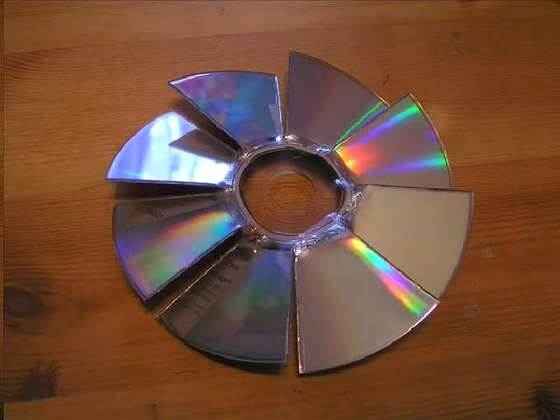
Creating Blades on a CD
- You can attach the disk to the cork with glue. The second option - when the hole in the middle for the cork will be burned - immediately connect the structure. The melted plastic will harden and hold firmly.
- After all this, the design is interconnected. For the stand, wire is suitable. This is perhaps the easiest option. Yes, and for such an easy device you can’t imagine any better. You can bend the frame in such a way as to quietly hide the batteries there. Or gently let the power supply wire go to the motor.
- The circuit should not always be closed if batteries are used, so the button must be fixed to the case. It is inexpensive. You can use it with a toy with which the motor was shot.
Another version of the propeller device is the use of paper, only thick. The method is even simpler, but less practical.
Advice! When experimenting, remember that the larger the fan blades, the more noisy it will be. On the other hand, small blades do not drive air as efficiently.
How to make a fan out of paper
Paper is not the most suitable material for a home fan for the simple reason that it is very impractical. Any ingress of water, even banal humidity - and the device will rapidly begin to lose in stiffness.
But even in spite of all the disadvantages, craftsmen even make quite nice patterns from paper. Of course, we are talking about thick paper or cardboard. Strong material from boxes is suitable. A regular motor or cooler, an on / off button and wires are also useful.
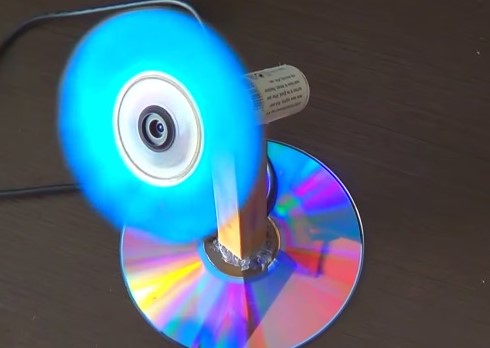
The easiest cardboard desktop fan
An approximate design plan is that the device can be simplified as much as possible. The impeller is easy to cut and can have as many blades as it is small. All at the request of the master. The motor can be mounted on a wooden or cardboard block. The stand will also come out of paper or an old computer disk.
It is important not to forget that such a fan turns out to be very light, which makes it shaky in operation. Therefore, it is necessary to further strengthen the housing. Old batteries, bolts or nuts will do well.
How to make a fan out of a plastic bottle
The favorite raw materials of Crazy Pens - plastic bottles - are almost ideal for creating your own fan. For the propeller, the top of a standard round bottle is a good fit. It is necessary to cut off the part with the cork just above the glued label.
- Part of the cork bottle will be blades. To do this, the plastic before the cork needs to be cut so that several different petals are obtained. After one, the petals are cut off at the base. The remaining ones are the future propeller blades.
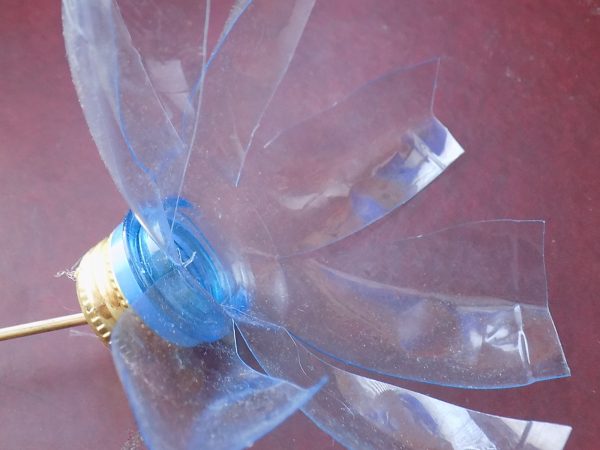
Plastic bottle fan blades
- To give the blades a shape and twist a little, you can use a candle or a lighter. The main thing is not to overdo it, because the plastic is soft and can catch fire. The task is to warm it up a bit, and not to set it on fire.
- The tube is the base of the propeller. A hole is made in it according to the dimensions of the motor axis. To keep the connection tight, you can put it on the glue.
- Now is the time to think about the foundation. The rest of the plastic bottle is also suitable for him. A hole is cut in it to firmly place the cork with the blades at a right angle. We must not forget to weight the base - with nuts, bolts or any other metal objects.
- A hole for the button is made on the base and the chain is assembled. There is enough space for a power supply.
The field for imagination when working with a plastic bottle is vast. You can use several bottles at once. One will become a propeller (more precisely, a part of it), and the second - a solid foundation. But then additional materials will be needed.For example, ordinary drinking straws.
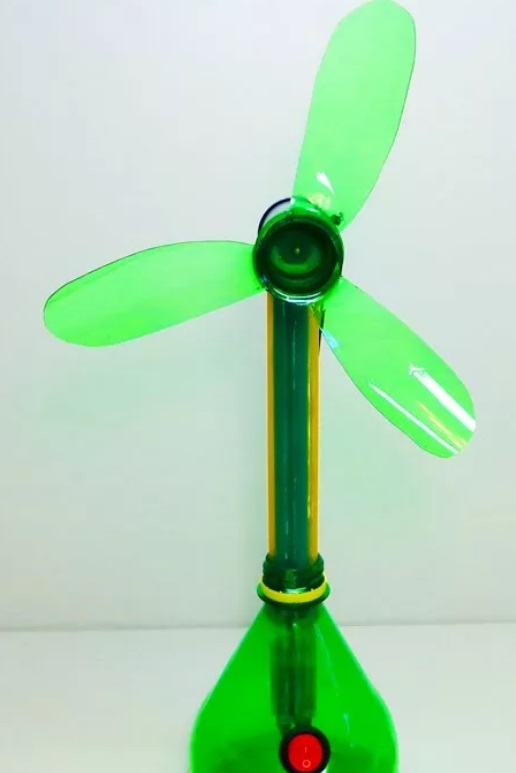
Simple and lightweight bottle fan
How to make a USB fan
But the most convenient and simple fan is the old cooler, which can also be used. For example, put it on a table, and it will cool, only not a processor or a video card, but a person.
The advantages of this design are obvious: the cooler is very reliable, because it is his job to constantly turn the impeller and cool something. And getting coolers is easy. It is enough to either find an old computer, or order a new fan or buy it in a store.
The cooler device is simple. This is a ready-made fan in a plastic case. Two wires (usually red and black) extend from it.
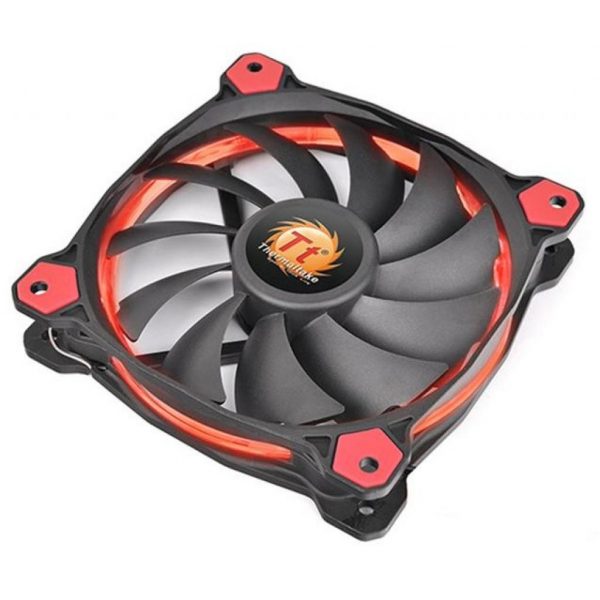
Regular computer cooler
Making a USB fan is a matter of minutes:
- The wires on the cooler are stripped 1-2 cm.
- An ordinary USB wire is taken, at the end of which you also need to get rid of the insulation. In the standard USB cable has four wiring inside. Of these, you should choose black and red. Cut off the rest, so as not to interfere, but to clean the necessary ones.
- Connect the red wire of the cord to the red one on the cooler. Black - with black. Carefully insulate areas without winding. Done.
- It remains only to think about the holding device. An already familiar wire that takes any shape can come in handy. Even a cardboard box is quite suitable for a fan case, and if you spend a little more effort and time, you can even build a real design object.

Design approach to fan design
It is very convenient when the fan turns on when the computer starts. In addition, modern units have several USB outputs at once. It turns out that such a device will not interfere.
Another point - sometimes you want to turn on the fan regardless of the computer’s operation (moreover, a device with a cooler turns out to be powerful enough, good and useful). Then you can use adapters. For example, today phones are charged, which easily turn into a USB cable when the plug and socket are disconnected. Similar equipment can be used for the fan, making it universal: working from the network and from the USB port of any computer. Another plus of this design is the simplest electrical circuit. A fan based on a cooler can do without even extra buttons: only a wire and a plug.
DIY fanless fan
But a little extraordinary use of a free cooler (but you can get by with an electric motor) is a fanless fan. A modern, interesting, with the right skill - no less effective - a solution that definitely captures the eye. The thing is completely non-standard, spectacular.
For example, here is the ideal appearance of a fanless or channel fan model:

You can do something like this without a fan and do it yourself
The most important thing in non-blade models is, of course, their appearance. Therefore, if you make such a device yourself, then you need to try to think through the frame in great detail. Rough edges, roughness - all this impression will spoil.
The case of a fanless fan is almost completely a working area. Do not think that some space technologies are implemented here.
Air circulation is carried out quite prosaically - with the help of rotating blades. They hide in a tube base. If you take the cooler from the computer, you can make a stand in its shape. Here, as they say, at the discretion of the author.
Differences from the classics in the location of the cooler - it is placed horizontally in the fanless fan.
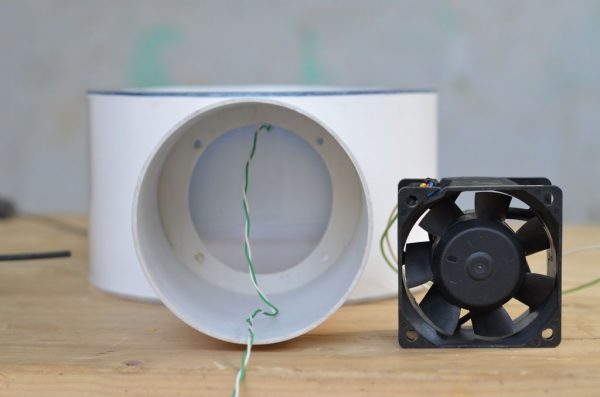
The location of the cooler in a fanless fan
The upper ring is hollow, two-layer inside. There, the main air redirection is carried out in the right direction.
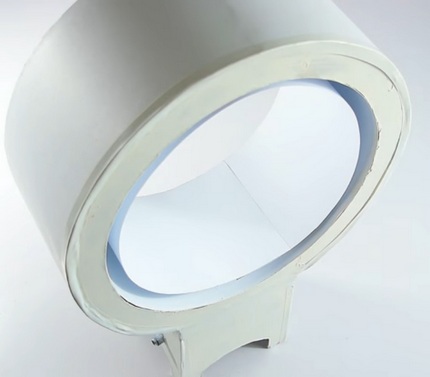
A hollow cavity is visible in the upper fan ring, from where air blows
You can make a skeleton of a fanless fan from plastic, wood, and cardboard.It’s better to use the material so that it can easily be shaped into a ring. As an option - apply a combined structure. For example, rings can be made of cardboard or plastic, and a rigid frame made of wood.
Need to cut:
- four sides for stand;
- Two circles of the same radius;
- Twist two rings of different diameters.
Then everything is connected together, if necessary - painted.
Meals can be arranged in different ways. A universal option is a combo wire for the USB connector and a plug for an outlet.
The device can also be a little complicated. For example, make a light strip of a diode tape along the rim edge. The backlight consumes little energy, but will add to the fan of beauty. And the power supply and wiring, if necessary, will easily hide a stand in itself.
How to make a powerful fan yourself
When it comes to powerful fans, you need to understand that they require completely different engines. Starting from the motors of the old fans, ending with other household appliances. Good fit:
- unnecessary ceiling chandeliers with a fan;
- old lawn mowers;
- drills;
- hoods.
The only thing you need to get into the voltage corridor, which is required to power the motor. For example, for drills, most often you need 18 volts. But for ventilation purposes, it will be enough to supply less than half of this voltage. Even at 12 Volts, the fans are very loud and extremely unstable due to the strong inertia of the rotating blades.
Power for powerful electric motors needs to be done from a network. Therefore, you need to think about installing a power supply or connecting a charger. The wiring diagram can be complicated by adding lit up bulbs, an electronic clock, a radio, a toggle switch or a board for switching operating modes. But it’s easier, of course, to limit yourself to just a fan with a button, if that is enough.
In any case, such homemade homemade fan variations are sometimes much better than even purchased options. With the proper skill, a very good thing can turn out, the real pride of the owner.



